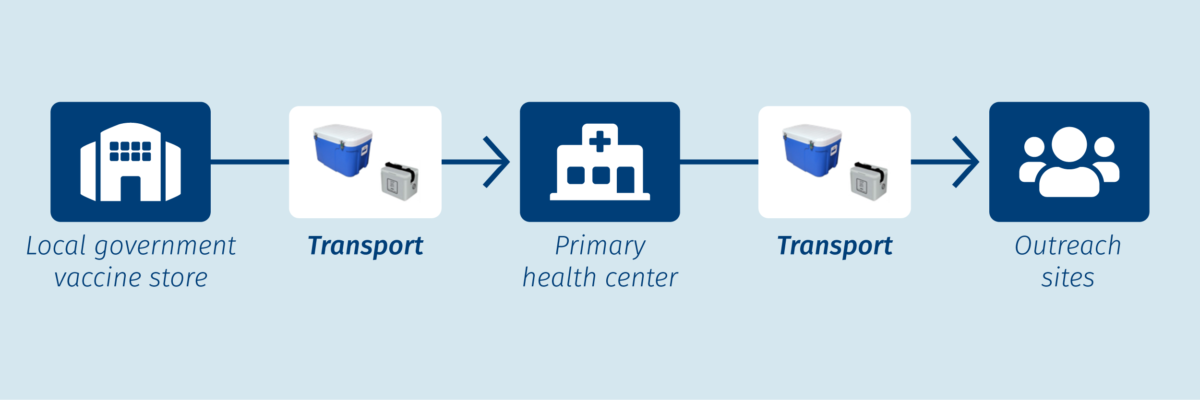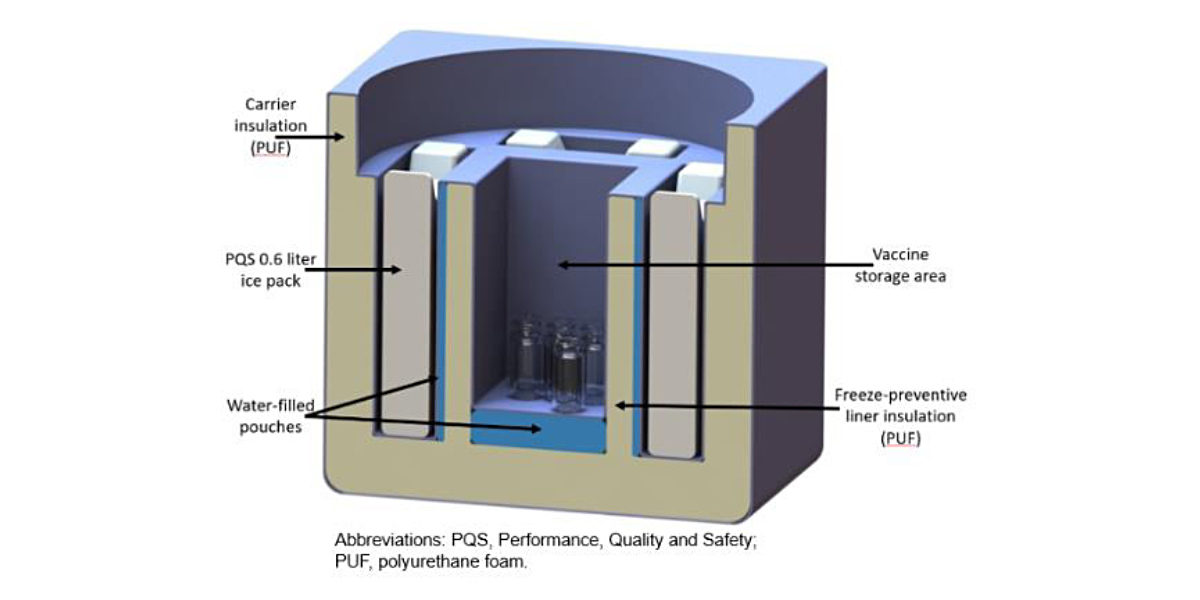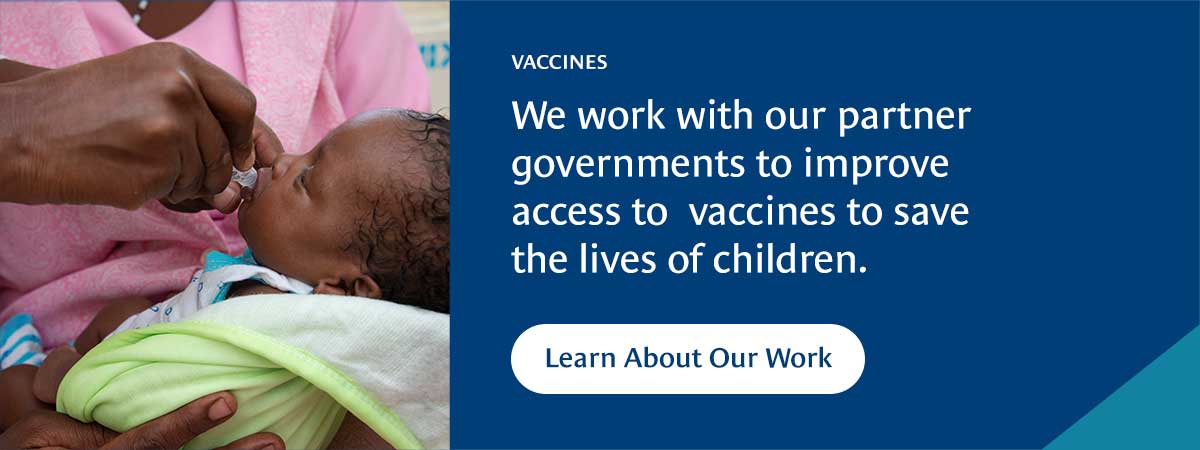Four times a month, Nurse Amaka* goes on a few hours journey by foot to some of the remotest settlements in northern Nigeria to vaccinate children who are unable to attend the immunization sessions at her primary health center due to the long commute. Every time she returns from these trips, she ponders to herself: Are the vaccines I immunize these children with still safe and potent?
Vaccine products are very sensitive to temperature changes and must be kept cool, but not frozen, for the entire journey starting from the factories where they are produced, all the way to the patient receiving an immunization shot at a clinic. If they get too warm, they spoil. If certain vaccines get too cold, such as those for diphtheria, tetanus, and hepatitis B, the active ingredients in the antigen solution freeze-up, and they can lose their potency within just an hour of exposure to freezing sub-zero temperatures.
Amaka carries her vaccines in a blue insulated plastic rectangular container slung over her shoulder with a thick black nylon strap. This crucial device should safeguard vaccine potency. Nevertheless, Amaka knows there are always risks.
First, she tries to follow the instructions on how to prepare the ice packs needed to keep the vaccine carrier cool during transportation; the frozen packs must be partially thawed before inserting them into the carrier. However, as Amaka exclaims, she is never quite sure whether she “melted the frozen ice packs well enough” to properly prepare the carrier and prevent the vaccines from freezing during her three-hour commute.
Secondly, she has no easy way to monitor the internal temperatures within the storage chamber to rule out any chance of freezing. This is concerning to Amaka because she knows that up to 60 percent of vaccines transported in these carriers are freeze-sensitive, and so extra care must be taken to ensure they do not get damaged.
To complicate things further, the vaccine vials often come into direct contact with moisture from the melting ice packs, causing the vial labels to easily peel off once she starts handling them. This makes it difficult for her to validate important information about the vial such as the expiry date, batch number, and vaccine type.
By the time Amaka arrives to administer the vaccines to children many hours later, the vaccine’s potency may have already been compromised and its ability to prevent life-threatening diseases severely diminished.
Accidental freezing in the vaccine cold chain is problematic.
Nurse Amaka’s story is a common challenge globally, as inadvertent vaccine freezing is one of the most persistent issues affecting successful vaccine management. A literature review assessing temperature monitoring across the vaccine cold chain found that 19 percent of vaccine shipments were exposed to temperatures below the recommended safe range in lower-income countries. The World Health Organization (WHO) recommends that ice packs should be “conditioned” or thawed into a slushy semi-liquid state to raise their temperature to above 2oC, in the process helping to prevent risk of vaccine freezing. Nevertheless, operational studies have also suggested that the recommended practice of preconditioning or thawing can be difficult to gauge or adhere to without training, as health workers like Amaka can attest. Additionally, the standard vaccine carriers suffer from design limitations that contribute to freezing risks; they do not have built-in partitions or barriers to prevent direct contact between vials and the ice packs.

Figure 2: Standard vaccine carriers without a barrier separating the vaccines from the ice packs.
Consequently, the responsibility for avoiding accidental freezing rests entirely with a healthcare worker’s adherence to the Standard Operating Procedure (SOP) for “conditioning frozen ice packs”. This is risky, as there is always some margin for error. Furthermore, the cost associated with wastage of freeze-damaged vaccines is high and becomes more costly with the introduction of more expensive, freeze-sensitive combination vaccines. To address these recurring issues, it is important to look to solutions that can reduce human error.
An innovative freeze-preventive vaccine carrier
To address transportation-related freezing risks for standard cold boxes and vaccine carriers, WHO developed new performance specifications for cold boxes and vaccine carriers that dramatically reduce the chances of freezing.
In 2015, several global health organizations including PATH provided technical assistance to manufacturers of WHO-approved vaccine carriers to help them adapt their existing designs to radically reduce chances of freezing. A year later, PATH published the freeze-prevention design as open source for manufacturers to freely adopt and bring to market. By late 2018, three manufacturers had developed a simple yet promising new vaccine carrier design with the potential to change the game for vaccinators like Nurse Amaka.
The new freeze-preventive vaccine carrier (FPVC) design was developed with an inner liner that contains foam and a thin layer of water as a phase-change material to separate the ice packs from the vaccines (see Figure 3). This liner buffers the vaccines from direct exposure to ice packs while .
CHAI conducted a pilot in Nigeria, to field-test the novel freeze-preventive vaccine carriers
In June 2019, CHAI supported Nigeria’s National Primary Healthcare Development Agency (NPHCDA) to pilot a rollout of three new freeze preventative vaccine carriers in several health facilities across two states. The pilot aimed to provide the government with real-world evidence of device performance in reducing the risk of freezing, and to evaluate their potential to replace existing vaccine carriers.

Figure 4: Three different models of the freeze-preventive vaccine carriers; AFVC-46 (1.5L), LEFF-FFVC (1.7L) and RCW 1 (1.04L) with a barrier separating the vaccines storage compartment from the ice packs.
At the end of the four-month field study, the device performance data revealed very promising results:
- The new vaccine carriers successfully prevented any cold or freeze exposure that would otherwise potentially degrade vials and negatively affect vaccine potency.
- No user intervention is required to mitigate freeze risk. The device is ready for immediate use – health workers simply acquire the device, drop ice packs into the fitted sleeves, and make their way to immunization sites. In addition to this critical benefit, there are indications that the devices reduce the amount of condensation build-up relative to the standard carriers, reducing the chances of vial labels peeling off.
- Some models come equipped with helpful design features such as waterproof backpack or shoulder straps, digital temperature displays, and specialized finger links on the ice packs to make it easy to insert and remove.
- The new designs reduce the training burden on staff when compared to those of the standard vaccine carriers.
- The time required to clean the freeze-preventive vaccine carriers after use is equivalent or less compared to the standard carriers in circulation.
- The new vaccine carriers reduced the amount of preparation time required by health workers. Nurse Amaka no longer needed to wait up to an hour for ice packs to thaw before inserting them into the carriers.
What this means for the future of vaccine transport
Based on the success of the pilot, CHAI helped Nigeria’s National Primary Healthcare Development Agency develop a strategic guidance plan to inform the future introduction of the new innovative carriers. This plan recommends key considerations suitable for the deployment of the carriers, either using a phased introduction approach or a complete country-wide switch. The plan also includes procurement guidance, logistics management, and training of personnel, which the agency can use when the country is ready for a national roll-out
Most importantly, this field evaluation adds to the growing body of evidence that freeze-preventive vaccine carriers are effective in reducing vaccine freezing risk during transportation, as well as to the development of global cold chain learning resources. An example of this is the recent interim guidance published by WHO titled “Selecting, commissioning and using freeze-preventative vaccine carriers”. This guidance document is intended to help inform which type of vaccine carrier to select based on local context to maintain vaccine quality, especially at service delivery points.
To date, five different freeze-preventive vaccine carrier models have been approved by WHO and can be found on the Performance, Quality and Safety (PQS) website and the UNICEF cold chain equipment supply catalog, where countries can purchase suitable new vaccine carrier models appropriate for their supply chain systems.
Keeping vaccines safe and potent when delivering them to the remotest places on earth is a complex task, which requires continuous human endeavor. —This new class of vaccine carriers equipped with freeze-preventive technology makes that burden lighter, gives higher vaccine potency guarantees, and shows how a simple design innovation can help solve difficult problems for health workers like Nurse Amaka.
*Name changed to protect anonymity.
References
- Freeze-preventive passive containers – technical resources curated at https://www.technet-21.org/en/topics/freeze-prevention
- Is freezing in the vaccine cold chain an ongoing issue? A literature review available https://www.sciencedirect.com/science/article/pii/S0264410X16309471
- Evidence of Vaccine Freezing in the Cold Chain. Available https://path.azureedge.net/media/documents/TS_cc_evidence.pdf
- Research disclosure: Freeze-prevention design for vaccine carriers, cold boxes and other passive cold chain equipment to prevent freezing of vaccines, drugs or pharmaceuticals in the cold chain available https://www.technet-21.org/en/library/main/4833-research-disclosure-freeze-prevention-design-for-vaccine-carriers-cold-boxes-and-other-passive-cold-chain-equipment-to-prevent-freezing-of-vaccines-drugs-or-pharmaceuticals-in-the-cold-chain
With contributions from Kikelomo Lambo – Manager, Precious Nwiko – Senior Analyst (Vaccines Program) and Precious Sunny – Associate Program Officer, (Sexual Reproductive Health), Nigeria.








